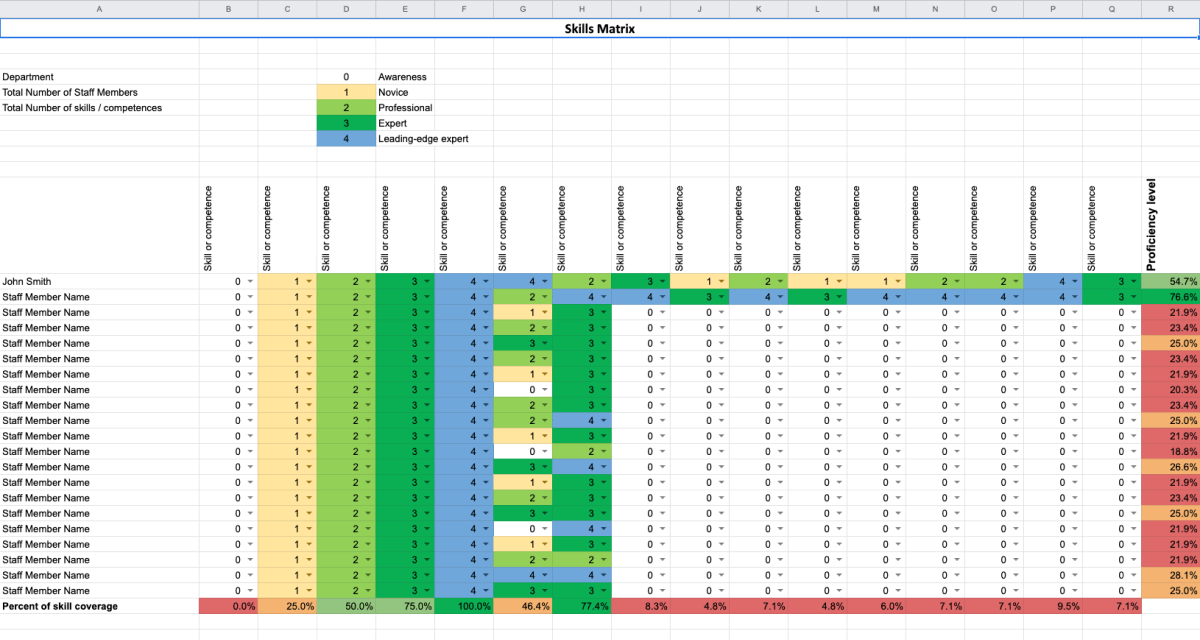Skills matrix
Discover how to use the skills matrix to identify available skills and find potential skill gaps. Learn how to create a skills matrix and how to use its data.

This description of a skills matrix can help you understand how valuable it can be for a company, in terms of knowing what skills and competencies employees have and how that might affect company sustainability.
After reading this article you will have ideas on how to use the skill matrix to identify available skills and find potential skill gaps. This might help you improve your employee learning and development and allow you to create better teams.
Discover:
- What is a skills matrix?
- Example of a skills matrix
- Why is a skills matrix important?
- What is the difference between a skills matrix and a competency matrix?
- Benefits of creating a skills matrix
- How to create a skill matrix
- Skills matrix template
What is a skills matrix?
A skills matrix is a valuable tool used to manage, plan, and monitor both existing and desired skills for a role, team, department, project, or the entire company.
It’s sometimes referred to as a competency matrix, and while the terms are often used interchangeably, we’ll explain the differences further down.
At its core, a skills matrix can be as simple as a table listing employees’ names alongside their skills, offering a clear way to visualize and track workforce capabilities
Example of a skills matrix
As we mentioned before the simplest skill matrix is a table with employees names and their skills or competencies with their evaluation.
| Team member | Communication | Campaign management | Content marketing | Webinar management | Social media marketing | Design skills |
|---|---|---|---|---|---|---|
| John | 8/10 | 7/10 | 9/10 | 7/10 | 3/10 | 2/10 |
| Elizabeth | 4/10 | 5/10 | 7/10 | 6/10 | 8/10 | 3/10 |
| Robert | 6/10 | 9/10 | 5/10 | 8/10 | 5/10 | 7/10 |
| Victoria | 8/10 | 9/10 | 7/10 | 9/10 | 7/10 | 6/10 |
| Edward | 7/10 | 4/10 | 4/10 | 3/10 | 4/10 | 8/10 |
| Anne | 7/10 | 4/10 | 6/10 | 7/10 | 9/10 | 3/10 |
Even a simple matrix can allow you to discover any missing employees’ skills that are needed or determine who needs some training.
More advanced solutions, such as Valamis Skills, will help you quickly track and manage the entire company skillset and save time.
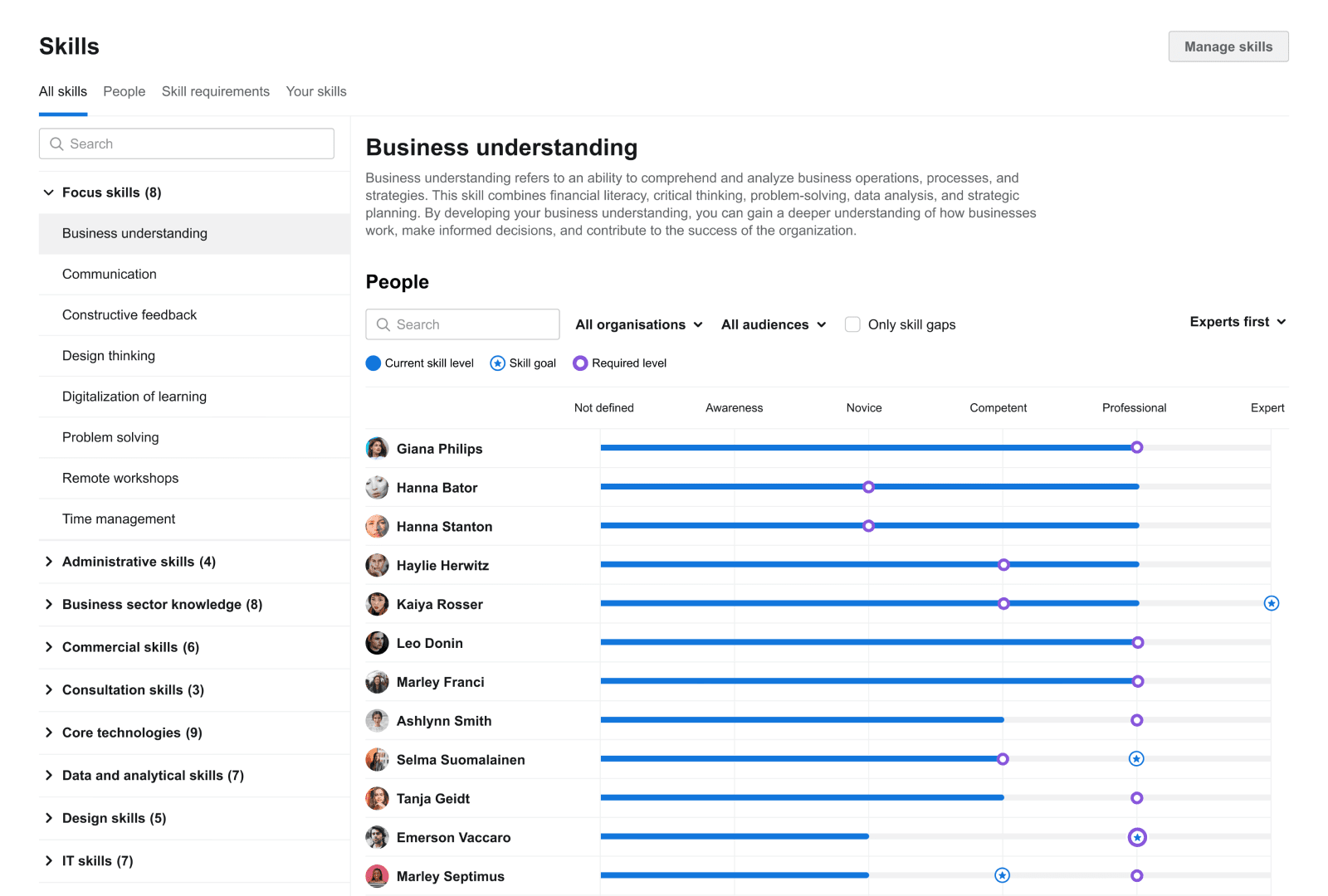
Why is a skills matrix important?
A skill matrix is an essential tool for any data-driven company, especially for HR departments and project management leaders.
It’s ideal for tracking your employees’ skills, qualifications, certifications, and competencies across the entire organization. When used effectively, it enhances team efficiency and contributes to overall business success.
A well-structured skills matrix helps you easily organize teams by identifying the skill sets needed for specific project requirements, ensuring tasks are completed by the most qualified team members.
It’s also invaluable to HR, as it informs recruitment efforts by highlighting skill gaps and assists in scheduling, ensuring the right mix of talent is always available, even during vacation periods.

Skills matrix template
Efficiently assess, manage, and maximize your team’s potential and streamline your workflow.
Download templateWhat is the difference between a skills matrix and a competency matrix?
The concepts behind a skills matrix and a competency matrix are essentially the same, but they differ in scope and application.
A skills matrix, as mentioned earlier, primarily focuses on evaluating employees’ specific skills. However, this only represents a small portion of their overall expertise.
On the other hand, a competency matrix goes further by incorporating not just skills, but also knowledge and attitudes. In this way, a competency matrix can be seen as an expanded version that includes a skills matrix within it.
Competency matrices are typically used by management to gain a holistic understanding of the organization’s available knowledge, identify gaps, and plan for future development.
Benefits of creating a skills matrix
1. Identifying the right people
A skills matrix helps you select the best-suited individuals for a job, task, or project.
It enables managers to build more effective and productive teams by filling roles with employees who are the perfect fit.
2. Identify missing competencies
Skills matrices highlight gaps in skills at the team, department, or company level.
If your workforce lacks critical knowledge or competencies that your competitors possess, your company may be at a disadvantage.
Additionally, knowing the required skills for a new project or initiative makes it easier to plan, meet deadlines, and achieve success.
For team members, it provides insight into strengths and areas needing improvement.
3. Identify the gap between employees, teams, and departments
“A chain is only as strong as its weakest link”
– Thomas Reid, “Essays on the Intellectual Powers of Man,” 1786
Understanding skill gaps can save your business time and money.
A skills matrix helps pinpoint where employees need further development, allowing you to provide targeted training or adjust project assignments for better efficiency.
4. Track employee development
Skills matrices provide valuable data for the L&D department, enabling them to determine which training programs are necessary.
Employees can also use the matrix to identify personal skill gaps and take proactive steps to improve.
Additionally, a skills matrix serves as a tool for career planning, helping employees understand the skills they need for advancement or promotions.
5. Help HR to find the right candidate
When an employee leaves, a skills matrix makes it easier to identify the skill set lost and hire a replacement efficiently.
It streamlines the recruitment process by clearly defining the necessary skills, helping HR hire more effectively and plan for future workforce needs.
6. Track your key staff members
A competency matrix enables you to identify employees with high-value skills and track their development.
Recognizing these key individuals helps ensure they are satisfied and engaged, and it can also guide decisions on promotions and recognition.
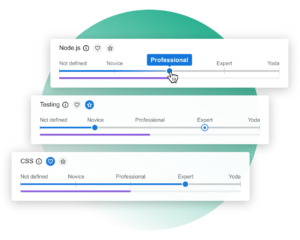
Connecting skills and learning
Valamis provides you with skills management and learning tools in the same platform, allowing you to tailor your content to existing needs.
Learn moreHow to create a skill matrix
1. Create a skill database
Skill database is the list of skills required for the role, department, or project.
At this stage, you need to define required skills by gathering and grouping them into different categories and even subcategories, e.g.:
- Communication
- Management
- Technical skills
- Technologies
- Problem-solving skills
- Data analysis
- Graphic design
- Marketing, etc.
Be as specific as possible when determining what skills are needed, and remember that soft skills such as communication, teamwork, and reliability are just as important as the hard skill sets such as knowing the technology or techniques.
We recommend starting with the most essential skills in the beginning. They should be related to the role or business in general. Although, keep in mind that the more data you have, the better decisions you can make.
One good way to create a specific skill set for a role is to ask more experienced employees about it. For example, you can consult highly skilled employees or department heads and ask them to write a list of skills required for different levels: beginner, senior, intermediate, and advanced. This will help you save time and will highlight specific skills you might not have considered.
One way to automate this is to use a learning platform with such functionality. At Valamis we created a competencies matrix with vast editorial capabilities.
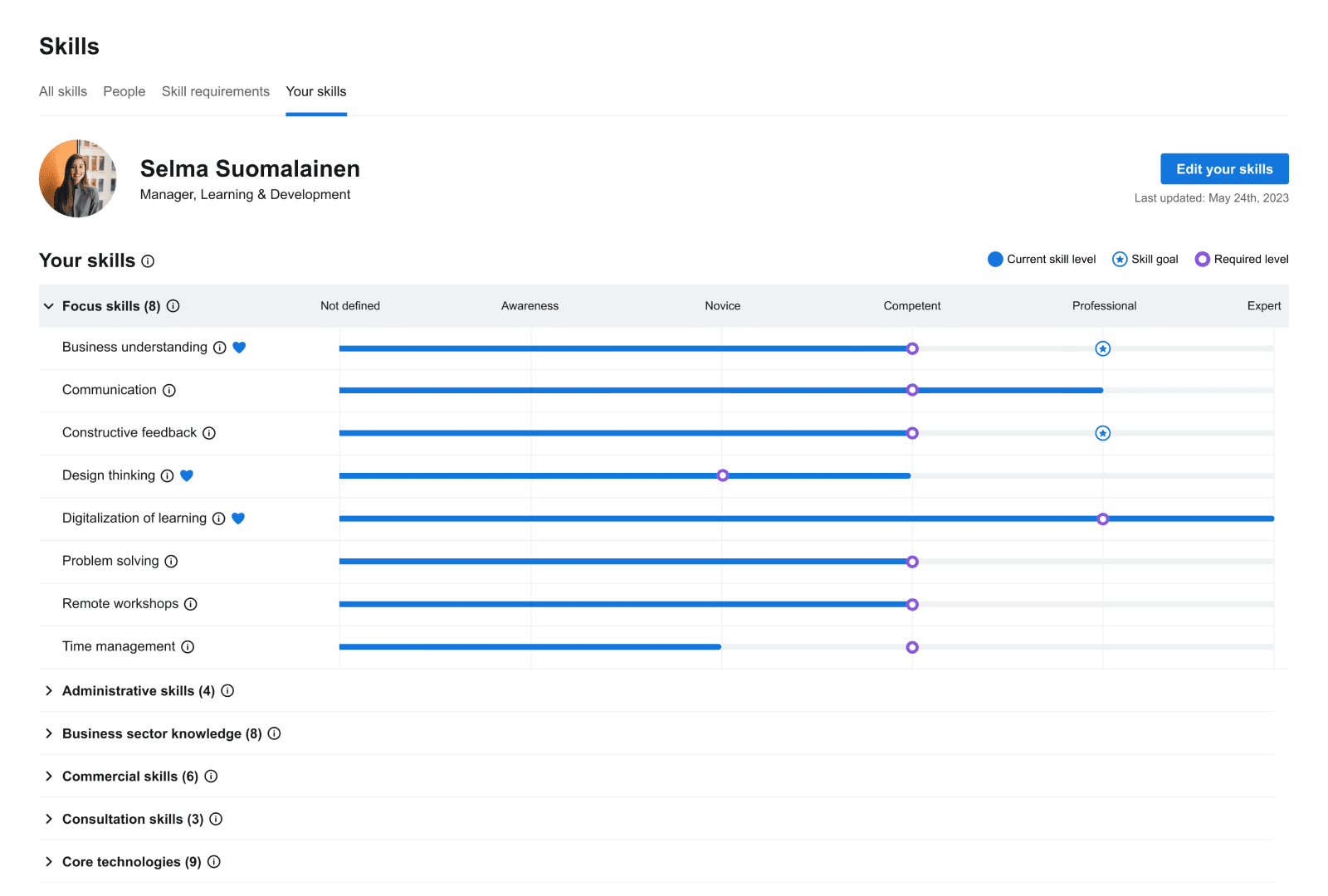
It makes it easier to create and maintain multiple categories and subcategories, edit, and delete skills. Moreover, you can assign numbers to each category to prioritize them according to your needs.
However, you can use Google or Excel spreadsheets; they will also do the job.
2. Create a grading system
A grading system is used for ranking the competence or skill level of users.
When you have a list of skills you need to define how you will grade them. For example, for the IT industry, Junior, Middle, or Senior could be levels of competence.
Consider that for different businesses and industries grading systems might be different, as well as for different roles and departments. You need to determine what works best for your organization.
For example at Valamis we are using the following grading system:
- Awareness – a person has a basic knowledge and understanding of the topic but hasn’t yet applied the skill at work.
- Novice – a person has applied the skill, but might still need support.
- Professional – a person has experience of utilizing the skill and can work independently. Solves problems proactively. Can guide and support more junior people performing related tasks.
- Expert – a person has a lot of experience in applying the skill in practice. Can communicate with customers about the topic and can coach others. Follows the trends of the field and shares knowledge with colleagues. Might have an official certification in the skill.
- Leading-edge expert – a person understands the bigger picture. Can discuss details with the client and advise the clients. Shares knowledge proactively, by, e.g., writing blogs or presenting at conferences or in Dev days. Follows the field and keeps the skill up to date.
Depending on the company size and diversity of the business, you might consider having several grading systems for different areas or departments.
3. Evaluate your employees’ skills
To do so you can use several techniques; each has its own pros and cons. We tried to order them based on speed and accuracy.
- Self-evaluation – an employee grades each skill personally.
- Manager evaluation – manager grades employees’ skills.
- Team or client evaluation – you can collect team or client feedback and use it to evaluate employees’ skills.
- Skills assessment – employees need to complete the tests or quizzes to determine their skills level.
- Certification – a fast and accurate method to evaluate specific skills, but not all employees have it nor can all skills be certified.
For a fast result, we recommend that you start with self-evaluation and certificates. Offer your employees the opportunity to assess their own skills based on the grading system and add their certificates.
If you need a more accurate evaluation, use skills assessment, or several methods at once.
Tip: add options for employees to select their favorite skills or skills that they would like to improve.
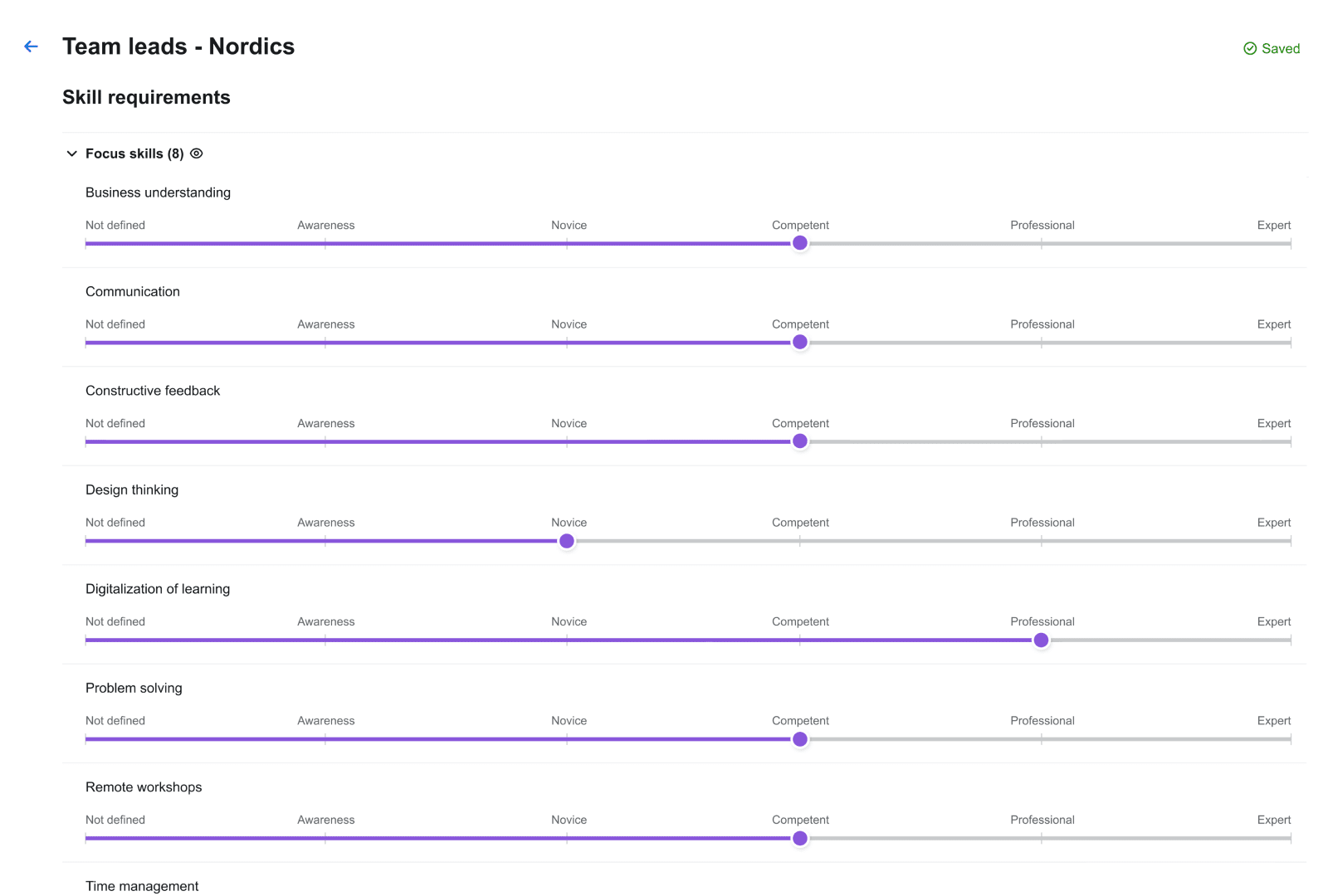
4. Visualize data and reveal insights
Even though this part can be optional, we strongly recommend visualizing the data.
This will help you discover quite insightful information right away.
Here are some ideas:
1. Calculate the sum of skill weights
Skill weight is numeric value for each skill level (e.g. novice – 1, professional – 2, expert – 3, leading-edge expert – 4).
When you have this parameter calculated for each employee, you can determine the most skilled people in the department or for the role, identify people who might need training or might be promoted, and gain many other insights.
On the screenshot, we filtered the software development team so you can straight away determine different groups of employees: team leads (most skilled group on the top right corner), medium and senior developers in the middle, and several junior developers in the left bottom corner.
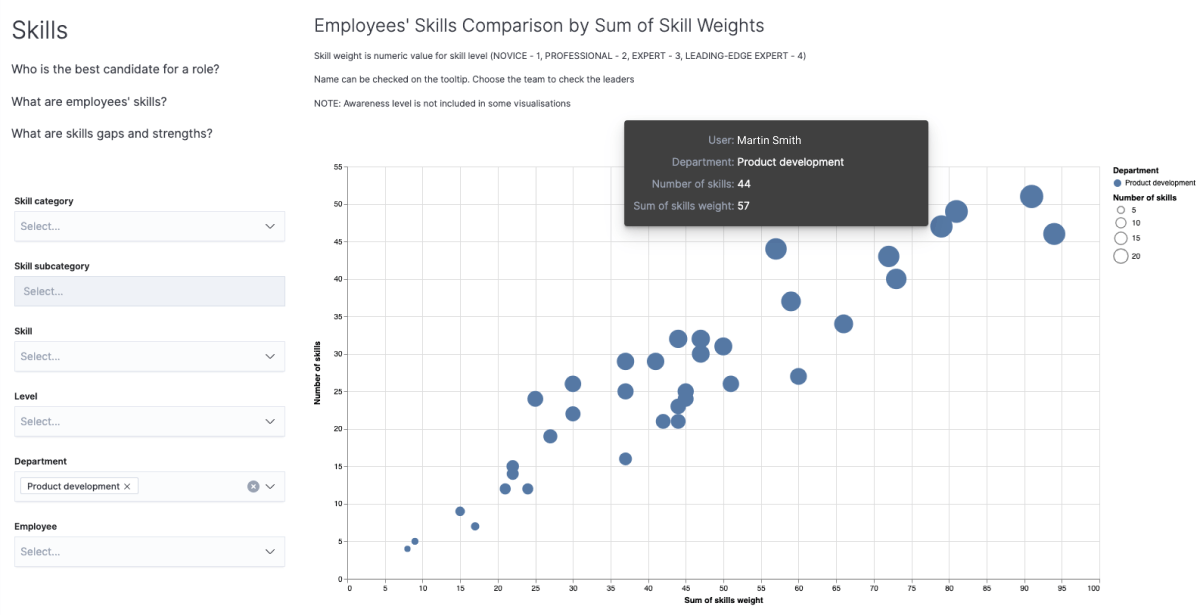
You can do the same for a specific skill or skill set, to find the perfect candidate for a role and form a team.
2. Define a potent skill loss threat
Such visualization is really valuable for determining skills that might be lost if employees leave the company. Usually, such a case happens when you have 1 or only a few employees with this skill. This is especially crucial if this skill is important for the department.
In this example, you can see that video and audio production skills, as well as media relations, are in a tight spot. Those skills are quite important for marketing, so losing people with this knowledge will require some time to recover. It would, therefore, be good to train more employees in these areas to handle it and be prepared for any potential departures.
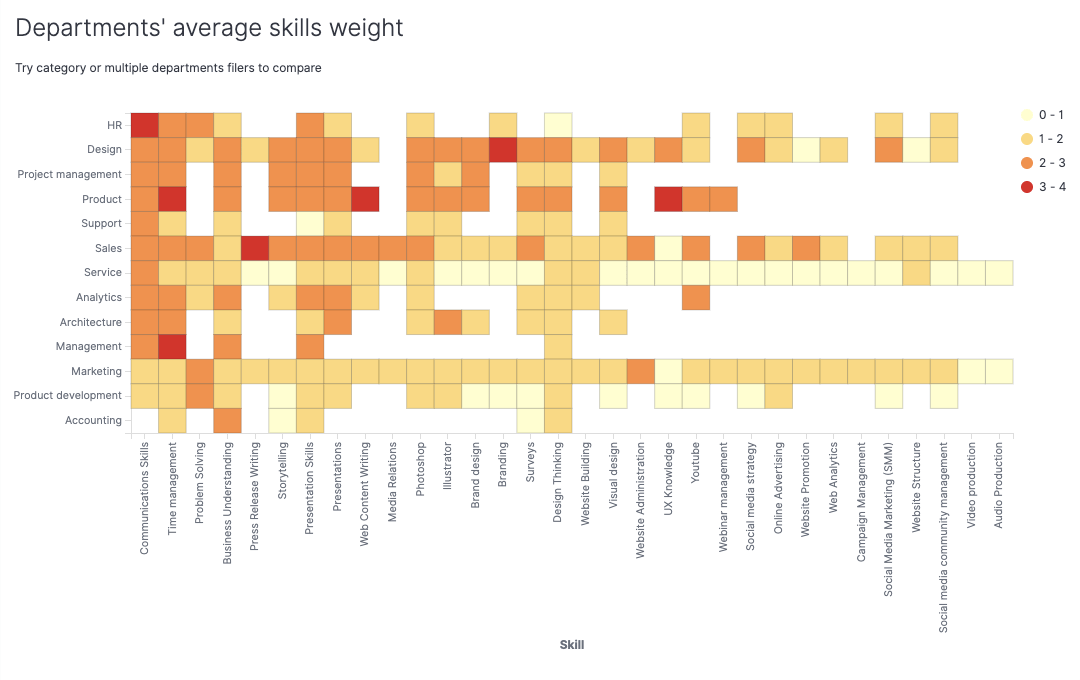
Skills matrix template
We prepared a simple skills matrix template that can help you start building your own skill matrix. You can use it as it is, or build your own based on the example. Make a copy and experiment with it.
Download skills matrix template Google Sheets / Excel (.xlsx).

